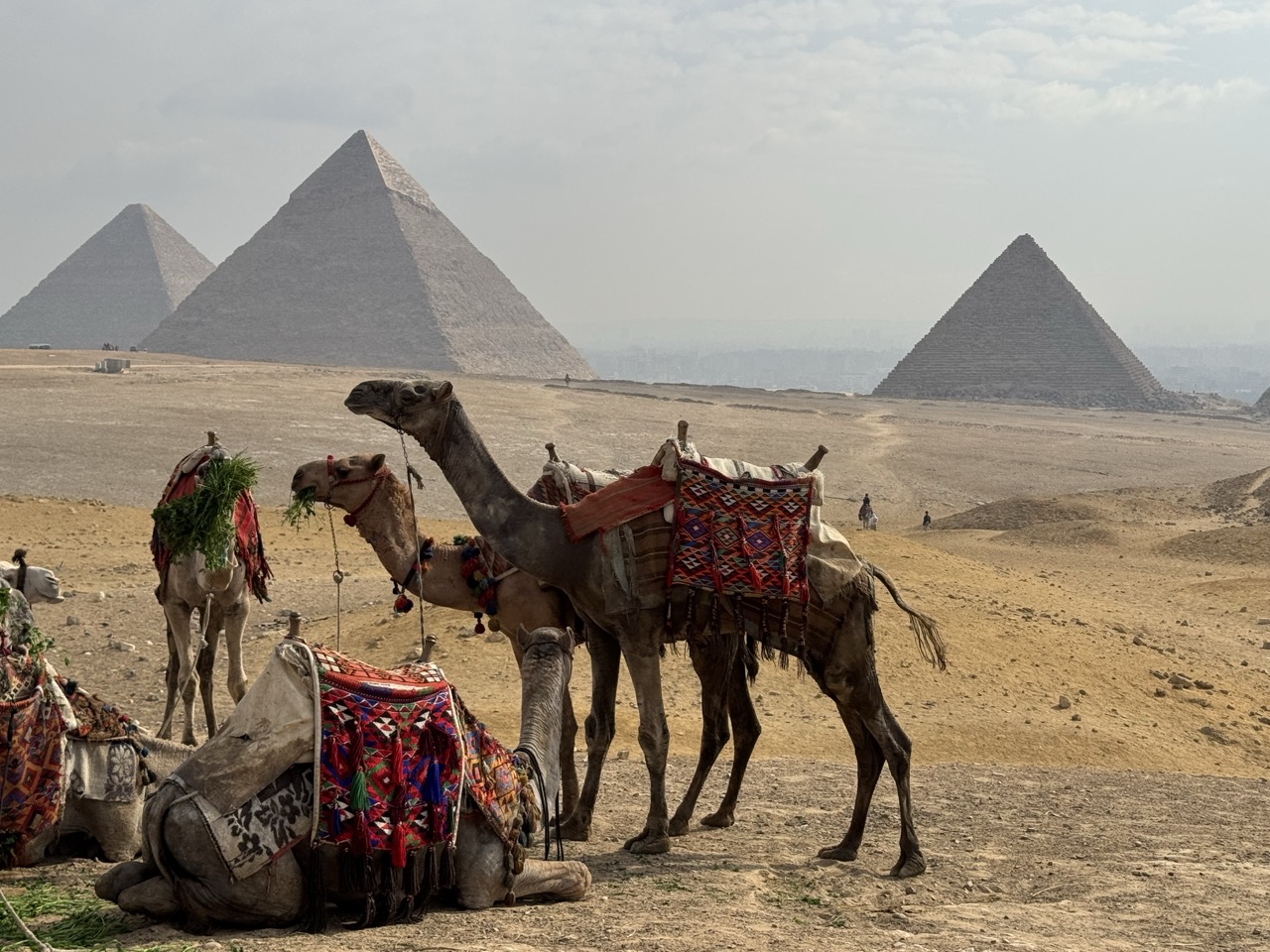In this review, we provide a day-by-day account of the package tour by Uniworld through what promised to be some of Egypt’s most wondrous experiences. The 12-day trip was taken by 2 of our team in late February to early March which happened to partially coincide with the religious period of Ramadan.
Pre-tour booking was well-handled by Uniworld, with all relevant documents being posted and emailed for good measure. As well as the checking in to flights, bags packed etc, you will also need to pay the tourist entry fee for entering Egypt that was $25 US per person when this trip was taken. It can be paid online in advance or in cash on arrival.
It’s advisable to get up to speed with vaccinations well before you go.
Let’s start from the beginning…
Day 1: Travel & Arrival
We were picked up by the Addison Lee taxi around 5am headed for London’s Heathrow airport. Although the driver was often taking his eyes off the road due to chirping on his mobile phone that was apparently offering him the next job, we were already looking forward to the sunny climes and amazing sights ahead.
Arrival was at Terminal 5 at 0625 for a 0905 flight which took around 5 hours to touch down in Cairo. Here, we were met on arrival by the very welcoming Egyptian Uniworld staff member, Sharif, who led us through passport control and to waiting Uniworld bus.
While being driven through the busy streets of Cairo, it struck us just how many people there were around and the high level of traffic on the way to the Four Seasons Hotel. It is is a very luxurious hotel and we were lucky enough to be in a beautiful room on the 26th floor.
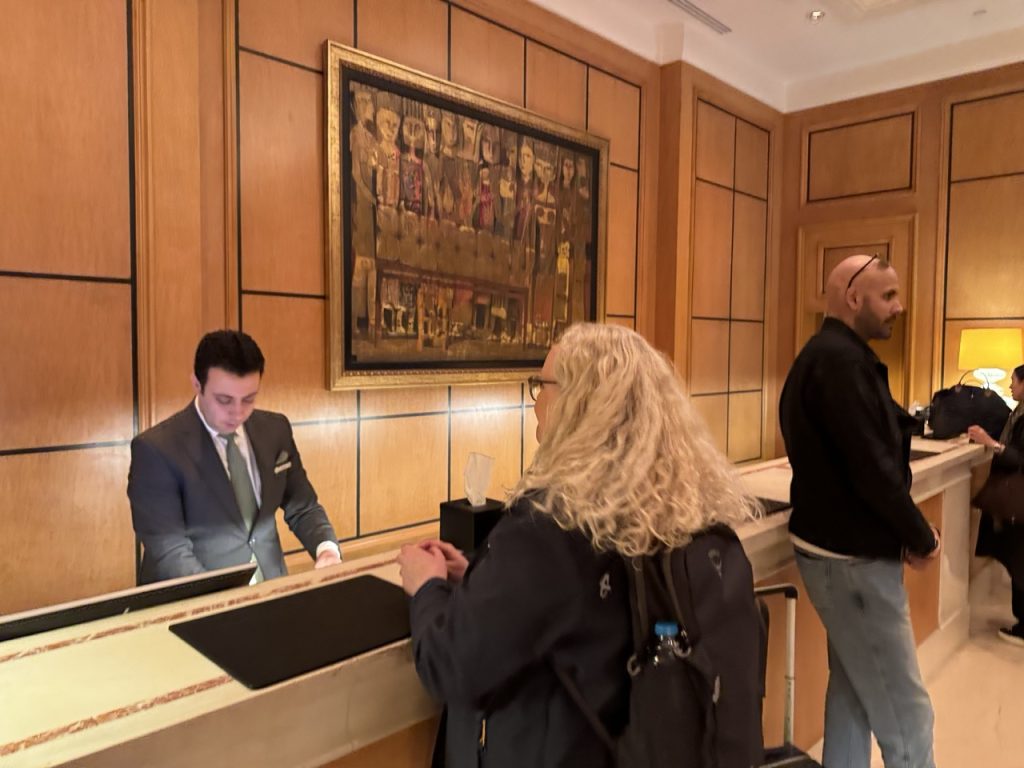
In the evening, we opted to eat at the internal Lebanese restaurant on the 5th floor. It has an indoor and outdoor eating area and the outdoor area faces the hotel swimming pool. This particular meal was not included in the Uniworld package. Dog-tired after this long old first day, we slept soundly whilst wrapped in Egyptian cotton.
Day 2: Cairo, Citadel, NMEC
The morning hotel breakfast was a buffet, very clean and with a great window view. Pastries and cooked breakfast, juices, fruit and a lot more was available. Following that, a briefing on the journey to come by the Uniworld tour guides began.
This talk was led by Egyptologist Mohamed, who it transpired would be the guide for those of us on Bus 1, or “Buswan” as it sounded to our non-Egyptian ears. At this point in the trip, the election of Uniworld’s ‘Masterpiece Collection’ add-ons could be applied. These are optional extras that you pay a bit more for as they are non-included excursions.
We added on the trip to Abu Simbel plus the Grand Egyptian Museum. This was $1010 USD extra.
At 0930 it was all aboard the bus outside Four Seasons to the Mosque of Muhammad Ali (aka The Alabaster Mosque in the Citadel).
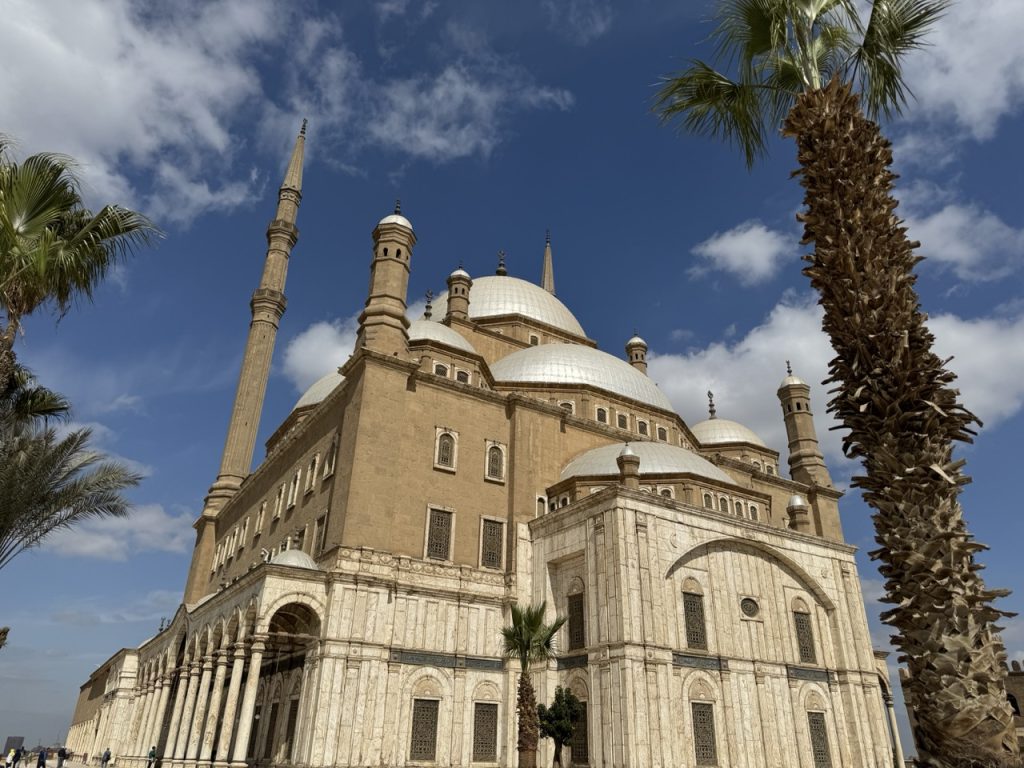
This is a beautiful area and the tour was well-narrated by Mohamed, explaining Muslim culture from inside the mosque. It was surprising to see just how many stray dogs and cats inhabited the area. From outside, a glimpse of what to come as the pyramids could be seen in the distance on the busy city skyline.
After that, the group boarded the bus to the National Museum of Antiquities (NMEC), set to arrive around noon. The journey exemplified how the streets seemed like perfectly organised chaos. Pedestrians could be seen walking between the traffic along the busy motorway, while cyclists and motorcyclists alike darted around without helmets between cars. When viewed from westerners’ eyes, this appeared very foreign indeed.
Then we arrived at the NMEC on this intensive tour. The NMEC features many important mummies and was absolutely fascinating. To be able to come so close to these well-preserved former rulers was quite something. No photographs were allowed to be taken of the mummified pharaohs.
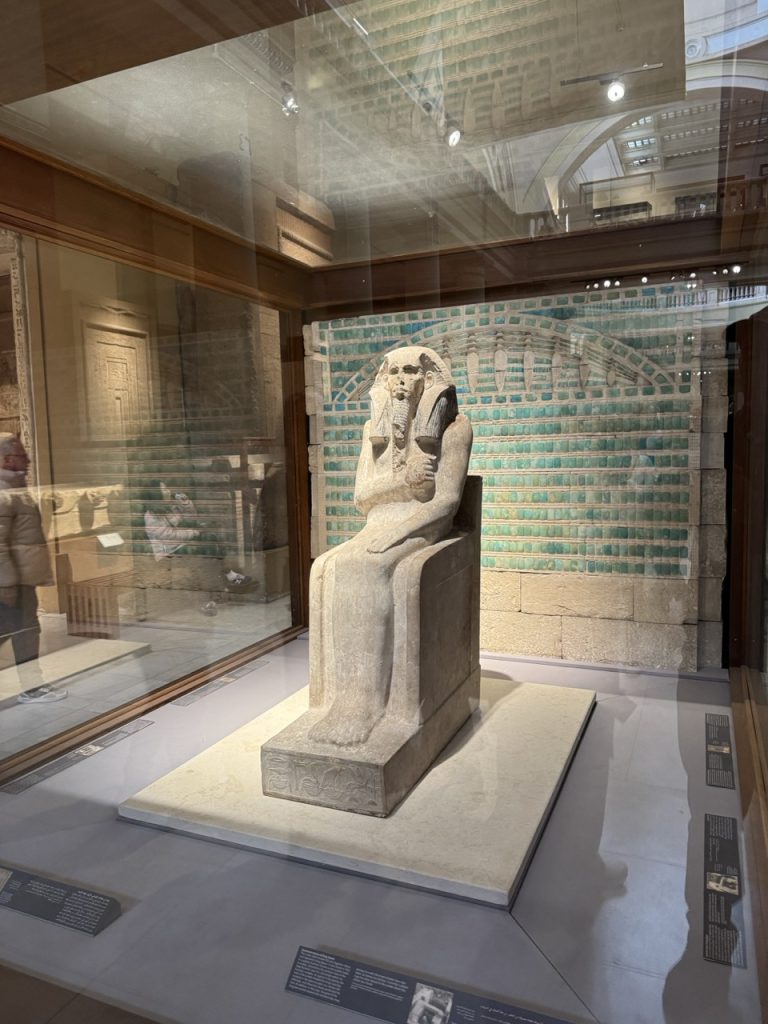
When that visit was over, it was back onto the bus took the Four Seasons Hotel to pick up others for the trip to the trip to the street bazaar. The street bazaar is a walk through a vibrant and bustling city street that is quite a sensory overload.
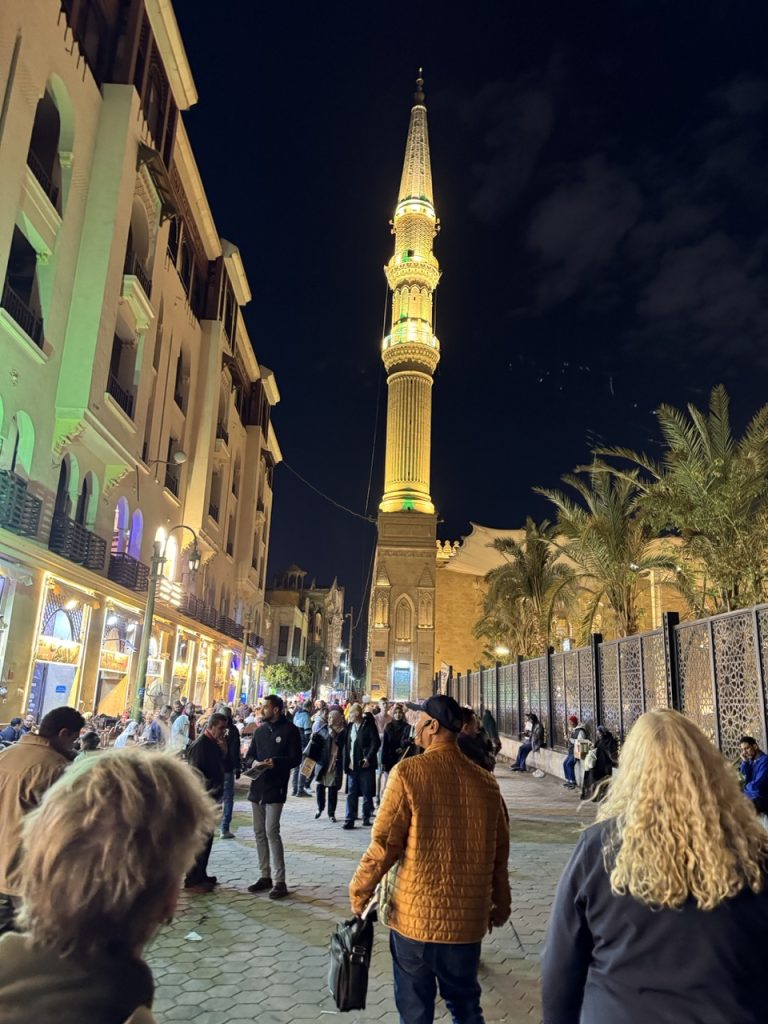
The street vendors can hassle you but it’s done in a pretty polite and respectful manner. It has to be said that a lot gets packed into day two of this tour.
There wasn’t even time to get lunch on this day! It might be pretty tiring for some, especially if you are also a bit jet-lagged, but all agreed that it was worth doing.
When the day was done, you needed to get dinner again (Tip: It’s recommended to book at one of the other restaurants in the hotel eg Italian or Chinese in advance or you likely won’t get in) under your own steam.
We chose the walk-in Zitouni restaurant due to not having pre-booked. Be forewarned that the next morning, you need to have bags packed and checked out by 5:05am due to the fact that you’ll be flying down to Luxor early doors!
Day 3: To Luxor and Boarding the SS Sphinx
During the internal Cairo Airways flight to Luxor in the morning, I’d recommend choosing a window seat if possible. Clear views of the Nile show how it breathes life into its’ east and west banks. You can see from the aeroplane how the greenery abruptly dissipates into desert scenes once the Nile’s water loses its impact.
Once on the ground, bags were taken separately as we were whisked from the Luxor airport directly to the Temple at Karnak.
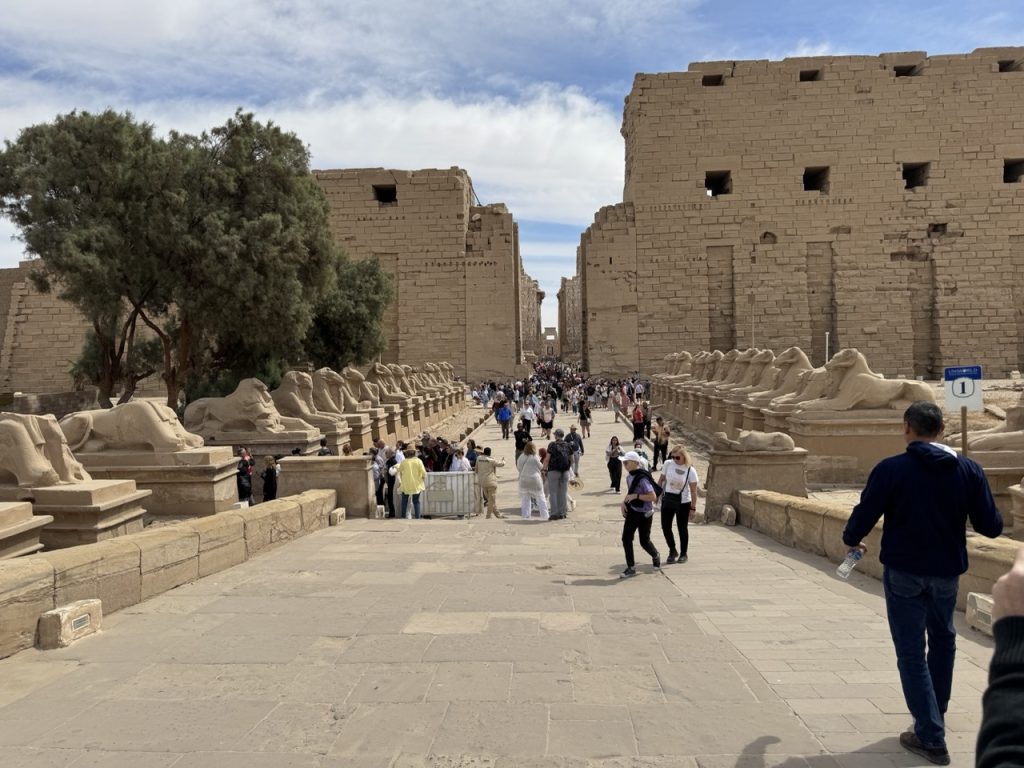
Next, it was on to our home for the next week or so, Uniworld’s SS Sphinx. The boat is designed in a classically Egyptian style, with a glorious sundeck. Take a look at these photographs that we took to give you an idea of what to expect.
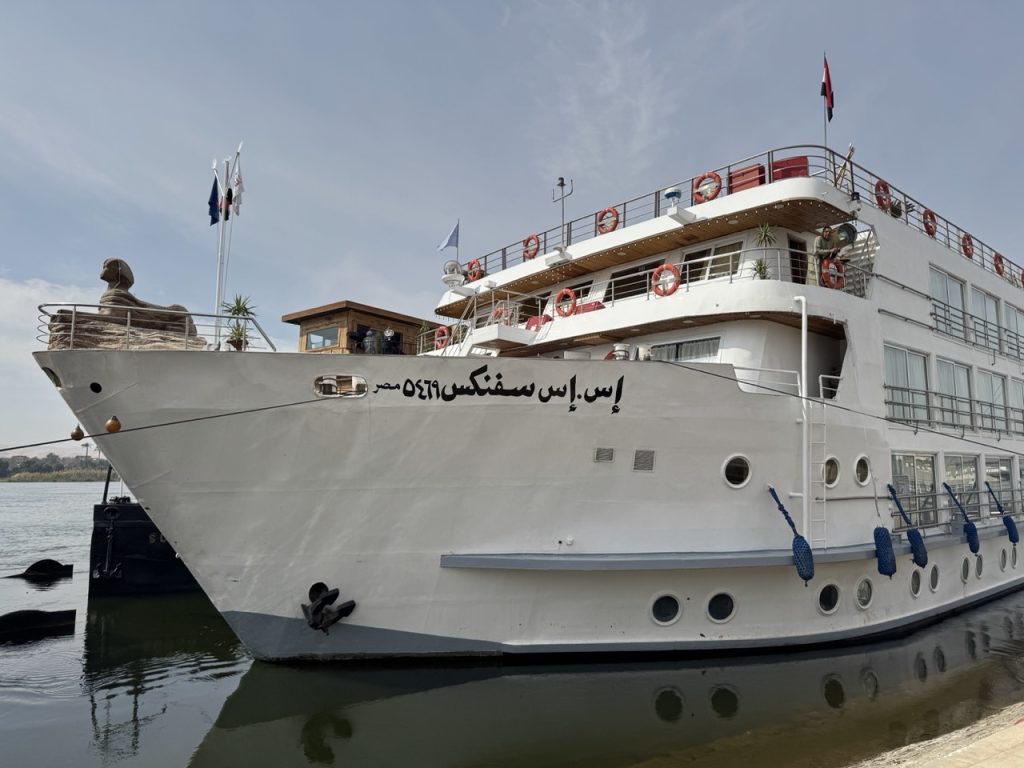
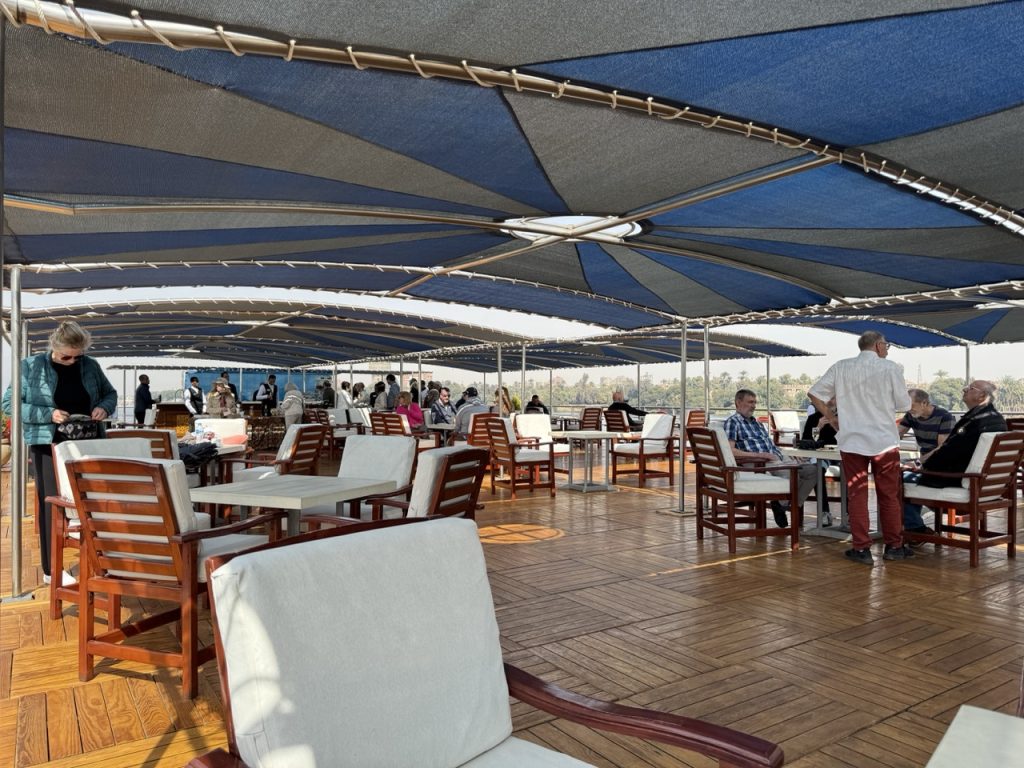
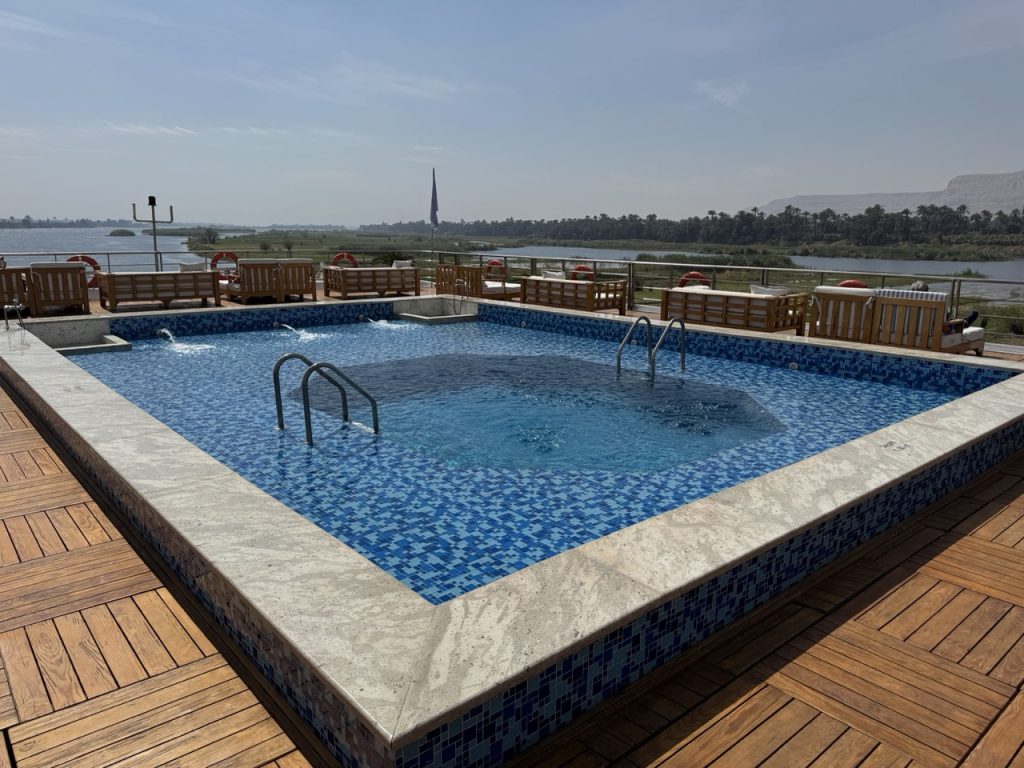
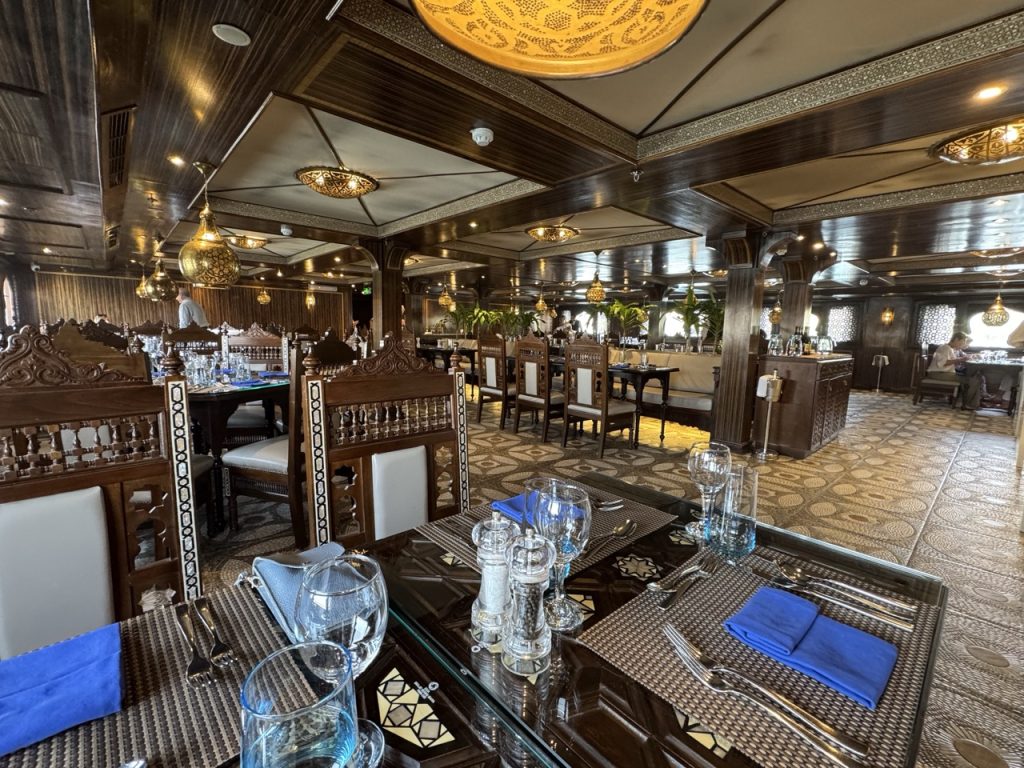
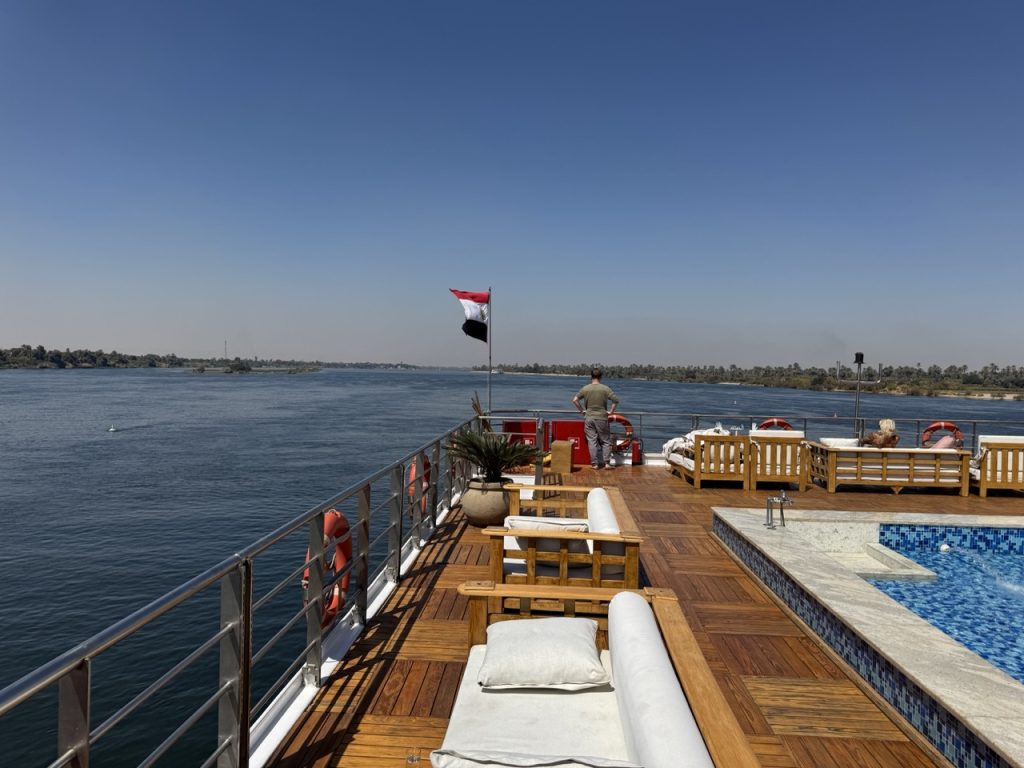
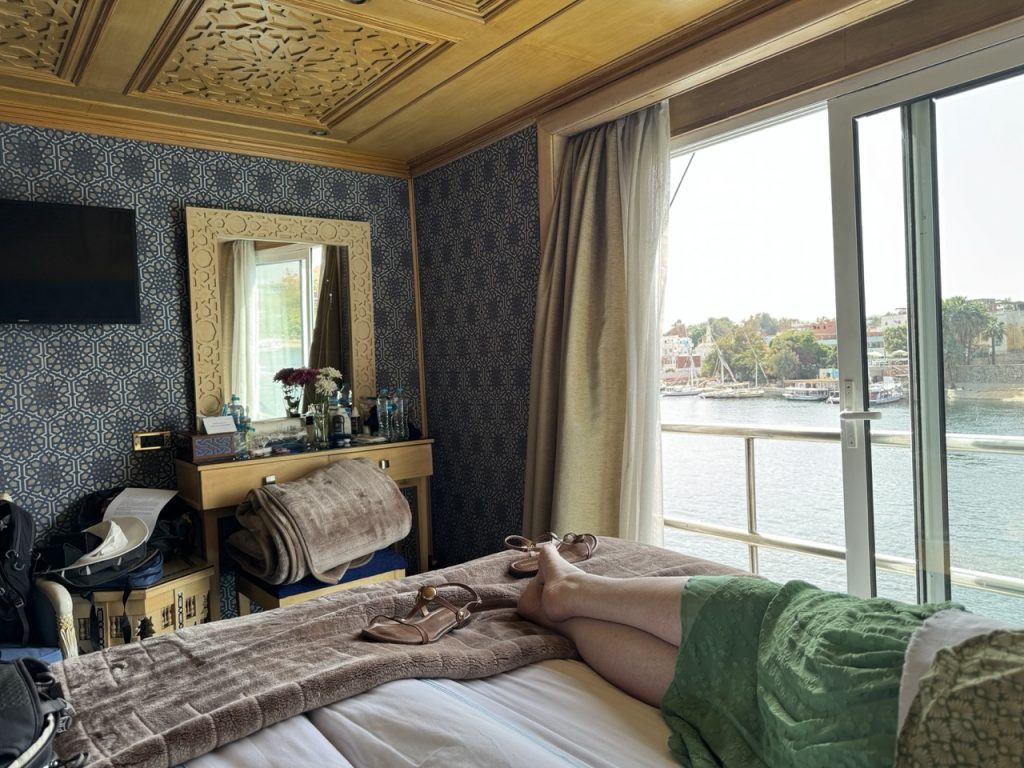
Day 4: Dendera and Luxor
The fourth day began very early – breakfast was made available from 0530 to ensure readiness to leave at 0700 for Dendera temple. The limited opening hours aside, this temple excursion to one of the best-preserved of all (the Temple of Hathor) is well worth doing.
Our very knowledgable Egyptologist, Mohamed, again provided fascinating insights and descriptions while the group was being led around the incredibly impressive construction. The minutely carved detail on the temple really has to be seen to be believed.
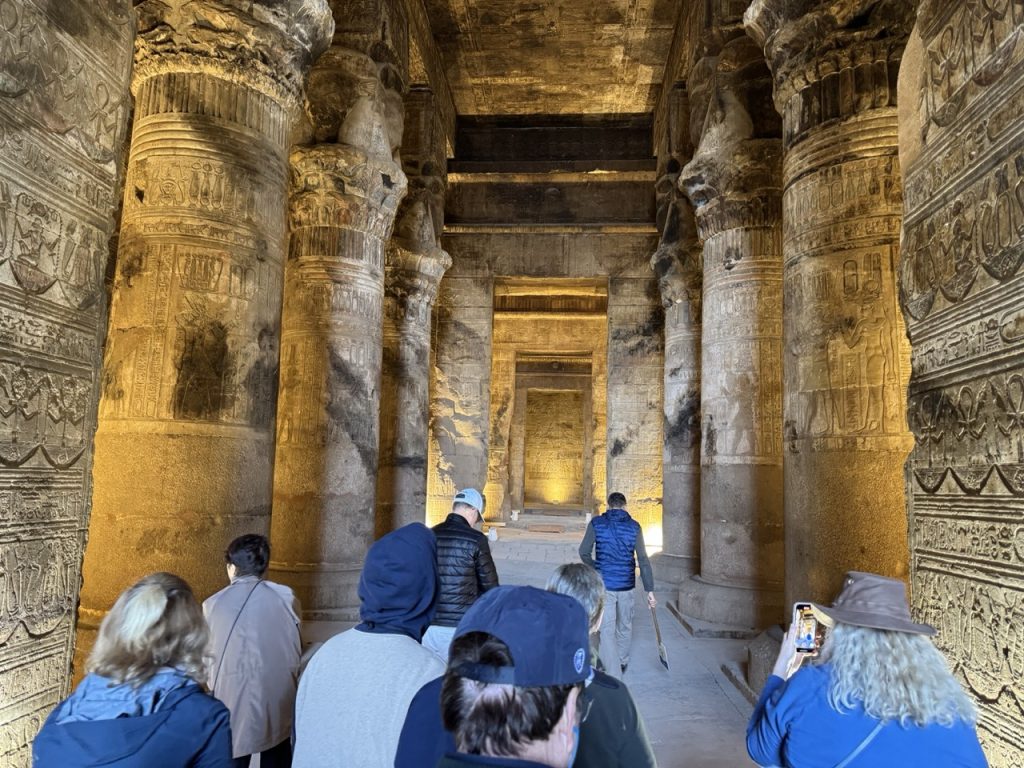
By 0930 the 2 hour visit was done and dusted. It was time to go back to the boat after a quick bus transfer and leave Dendera to return to SS Sphinx which sailed back to Luxor.
On this river journey back, it was an excellent opportunity to head to the sun deck and take in breathtaking scenery on the palm-tree lined banks of the Nile. Many enthusiastic people going about their daily business waved and shouted greetings to those on the sun deck. This was mainly led by Egyptian children but adults happily did the same from the riverbank and rowing boats.
There was a 1230 Lunch on board and rest time provided ample recovery for arrival at Luxor to take the 1630 excursion to Luxor temple.
The temple at Luxor was yet another amazing walk through the rich history of Egypt. The sphinx-lined street that leads up to the impressive entrance is a build up to what’s to follow. Mainly, that’s a beautiful shrine to (and by) Rameses II.
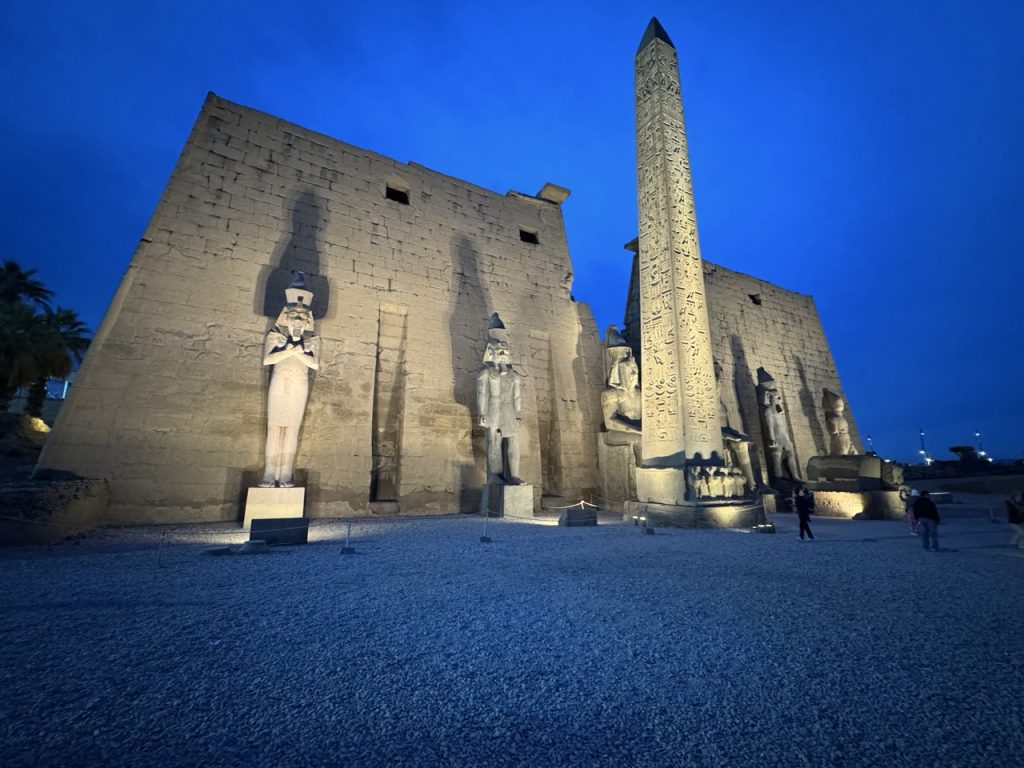
There is also an interesting area near the rear of the temple where Alexander the Great added himself into the story during his time. And who wouldn’t want to be part of this rich history?
There was also the option to visit Luxor Temple in the evening when it was lit up.
Another deliciously prepared dinner on the SS Sphinx was just the tonic to round out the day.
Day 5: Luxor
It was up early again for the fifth day of this Egyptian adventure. Breakfast was over before 0645 which was the time the bus was needing to be boarded. This was a journey to another world-famous destination. En route, we stopped off for a photo opportunity at the Colossi of Memnon.
This was made particularly picturesque at the early time of day. The sky was also dotted with hot air balloons, which was an available option for Uniworld travellers as an additional cost experience.
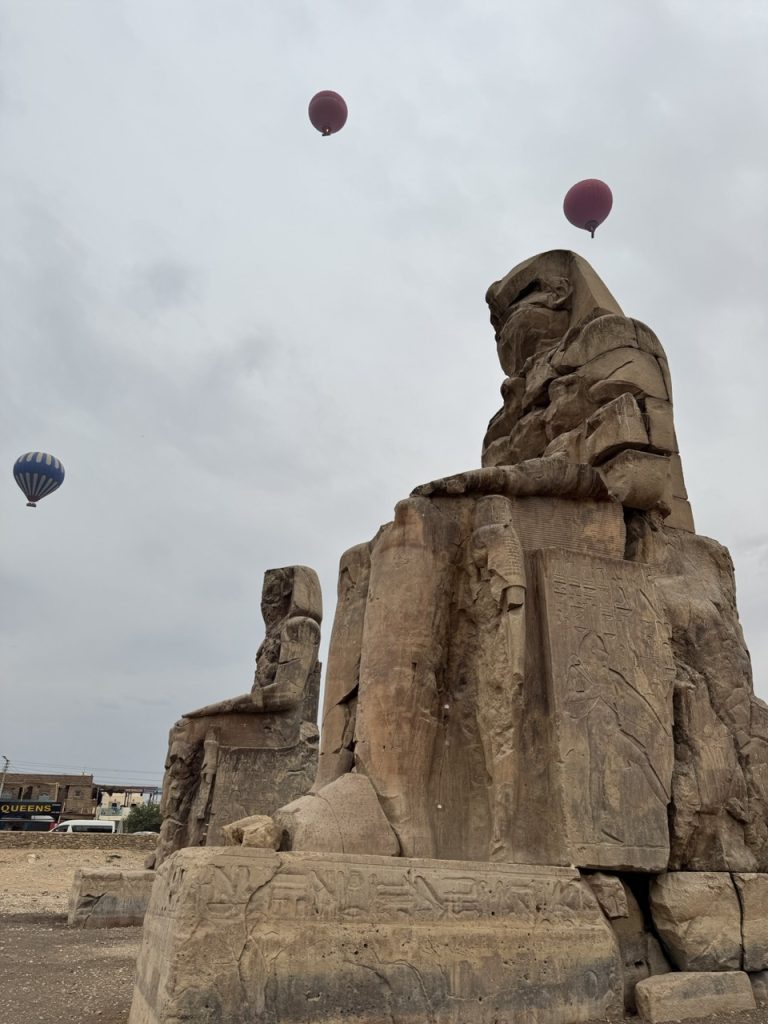
Once the bus had welcomed in the patrons who returned from their balloon trip, it was on to the much-anticipated Valley of the Kings.
Seeing the mummified body of the young king Tutankhamen and walking into his tomb was a very special and exhilarating experience. Mohamed had picked out the most interesting ones to visit, including that of Rameses III.
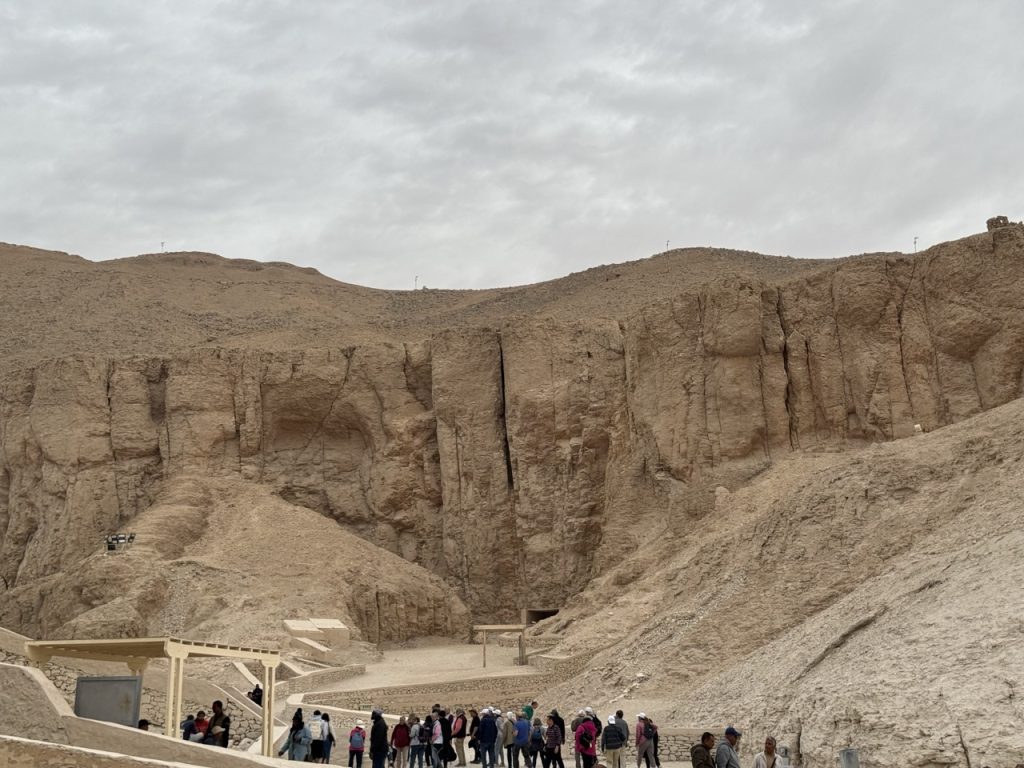
An interesting fact is that the longest-lived pharaohs had the grandest tombs, as work on these began when their reigns did. Those who were not rulers for very long thus had less work done on theirs.
Hatshepsut Temple was visited to complete this section before going to a local alabaster shop for those who wanted some authentic works of local art.
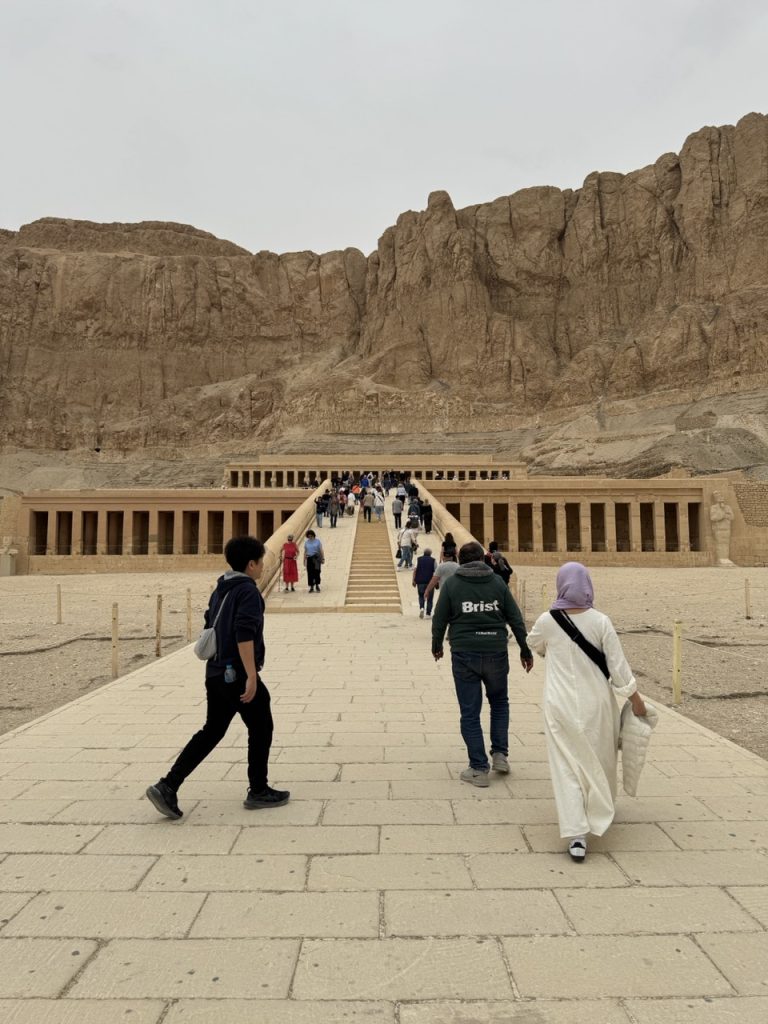
Then it was back to the ship to grab lunch on the way to Kom Ombo.
Day 6: Kom Ombo and Aswan
A less punishing time schedule for day 6 saw the excursion set off on foot from the boat to Kom Ombo temple which was just a few minutes away after wading through some pretty exuberant street sellers.
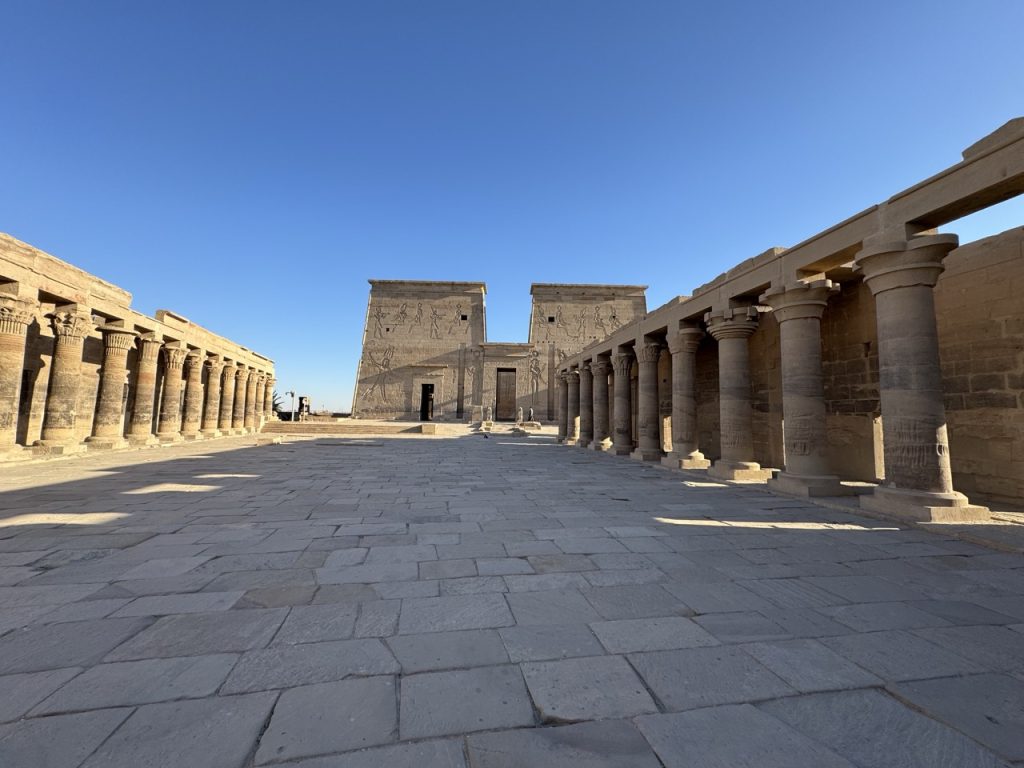
One of the most interesting aspects of Kom Ombo were the hieroglyphic references to dentistry and medicine.
Once finished, there was a visit to the mummified crocodile museum. Yes, you read that right, the ancient Egyptians didn’t just mummify people!
Following the return to the boat by 10am, a Zumba class was offered on the sun deck for the energetic and then relaxation time watching the world go by on the Nile en route to Aswan by 1430.
From there, it was all aboard a felucca (a powered boat) on the Nile to enjoy some scenery and also see some native birds.
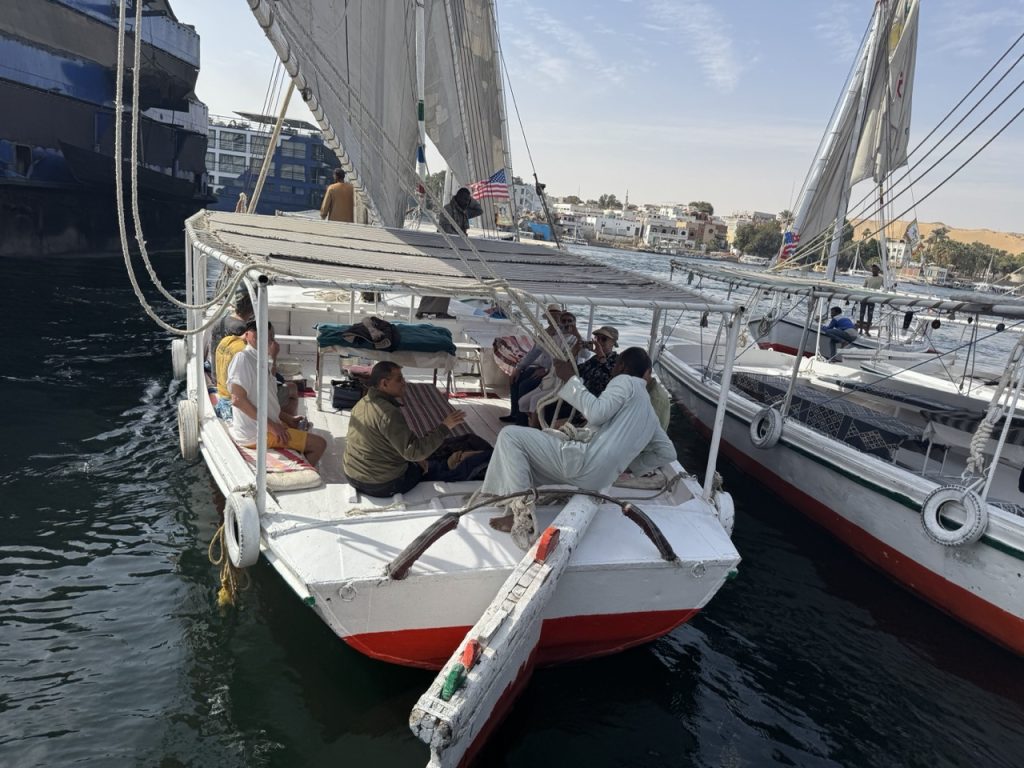
When back, it was a change of attire into something a bit more semi-casual. That’s because we were taken to famous Aswan landmark, the Old Cataract Hotel for a spot of afternoon tea.
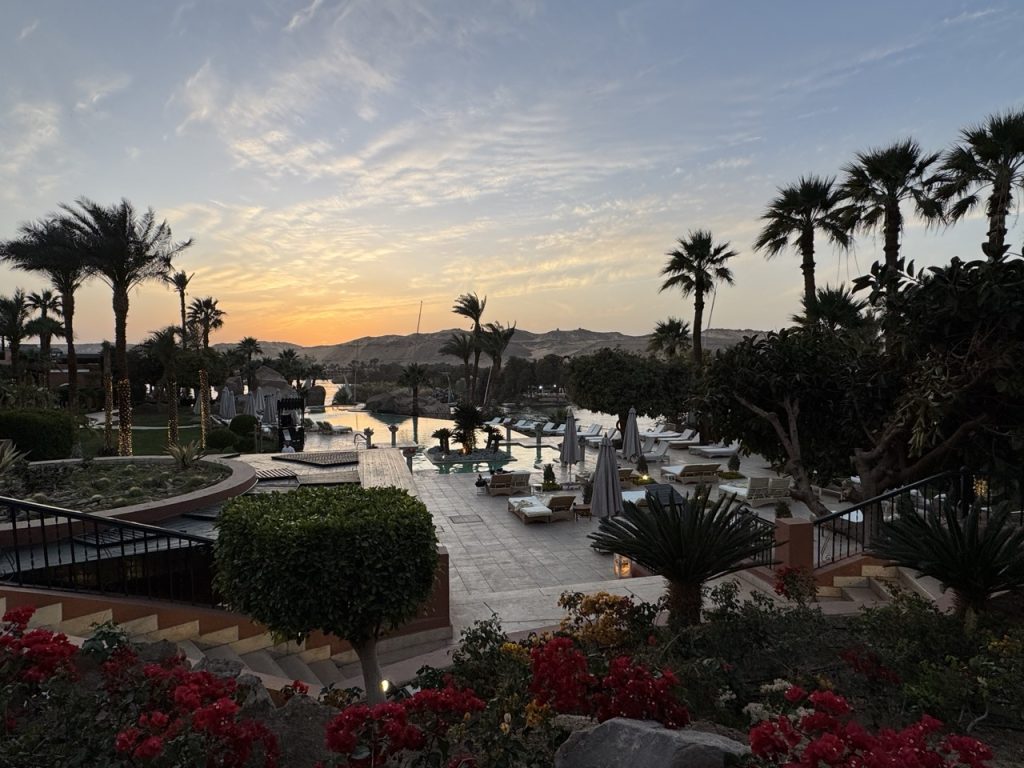
This is where Agatha Christie wrote some of her famous murder-mystery book, Death on the Nile, and the hotel also featured in the classic feature film.
Day 7: Aswan High Dam, Philae Temple, Unfinished Obelisk, Papyrus
Day seven was another jam-packed adventure for the travellers. It began with a tour to the Aswan High Dam which was needed to be built to stop the Nile from overflowing at that point. Interestingly, this is the demarcation point where the crocodiles do inhabit the river.
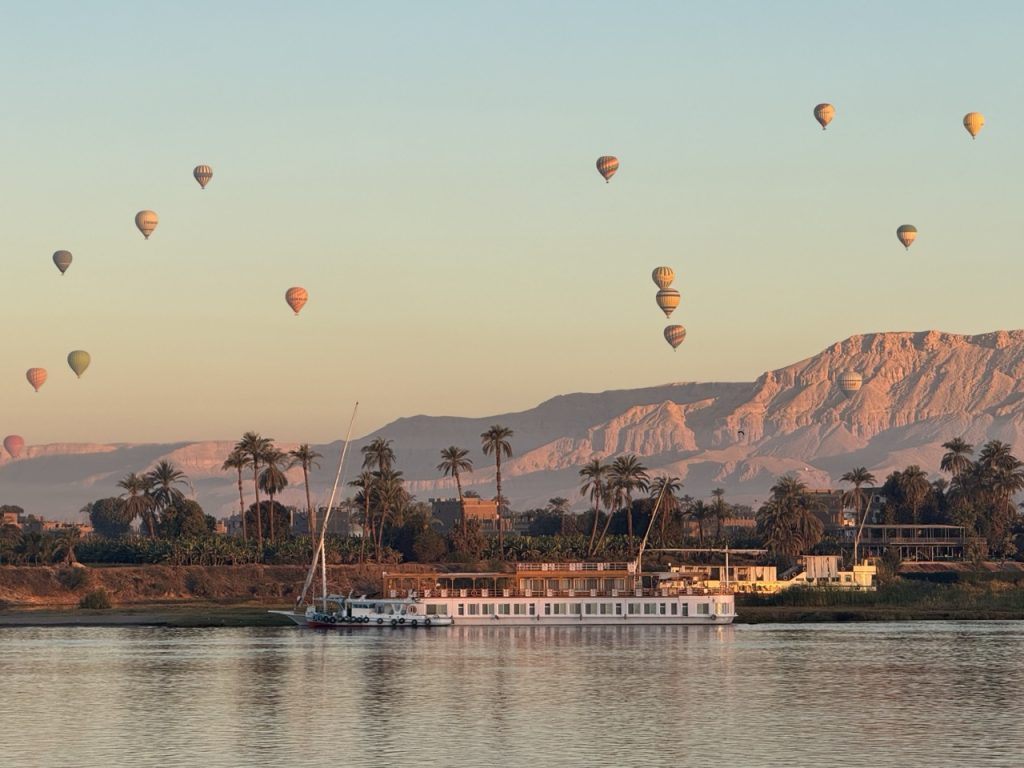
Philae Temple was the next stop on the journey and, as you can see from the photographs I took below, it’s another beautifully preserved example of Egyptian architecture. Mohamed was, as usual, full of knowledge that he imparted. By this point, the information was flowing thick and fast! So much history.
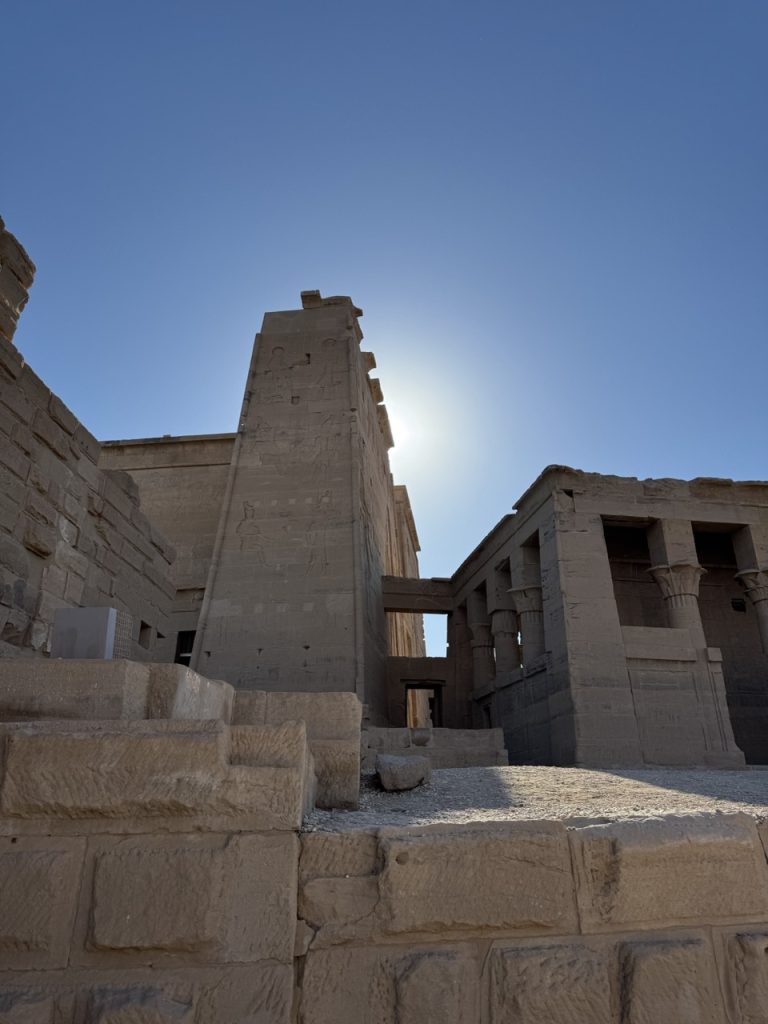
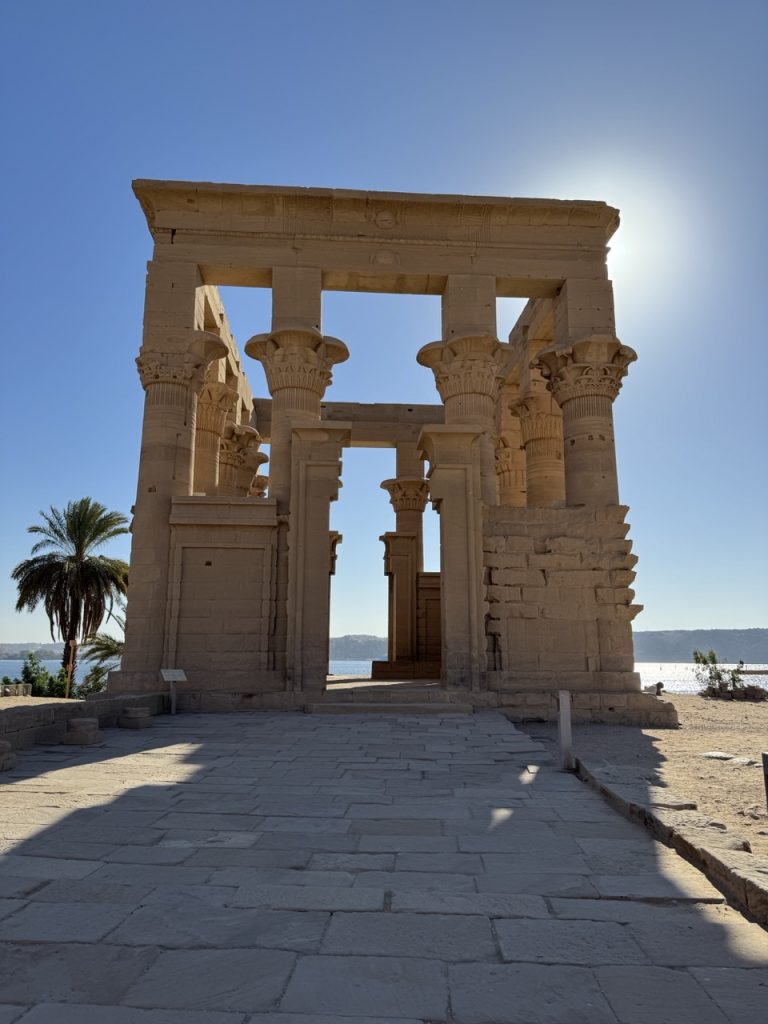
Next was a trip to see what is known as the unfinished obelisk, which was set to be removed from the quarry before if cracked in the lifting process. What a pity. However, it remains in place there for all to see.
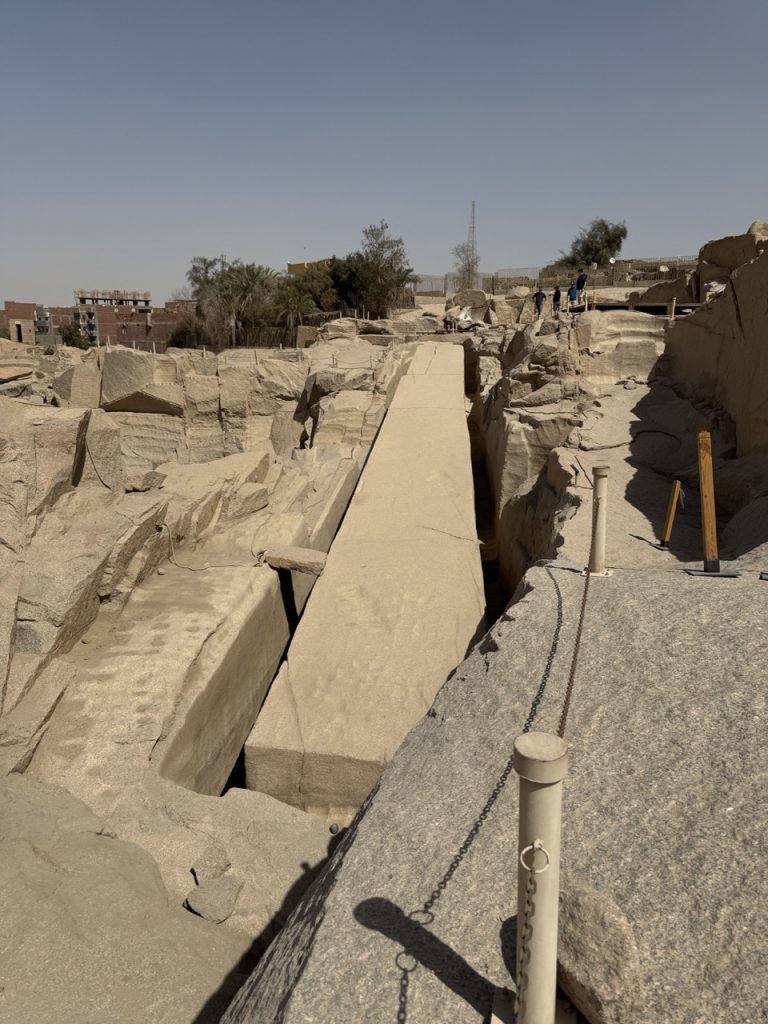
An opportunity to see how papyrus is harvested and created with art on it was next. This was fascinating, and this stop also gave travellers the opportunity to purchase some art for taking back home.
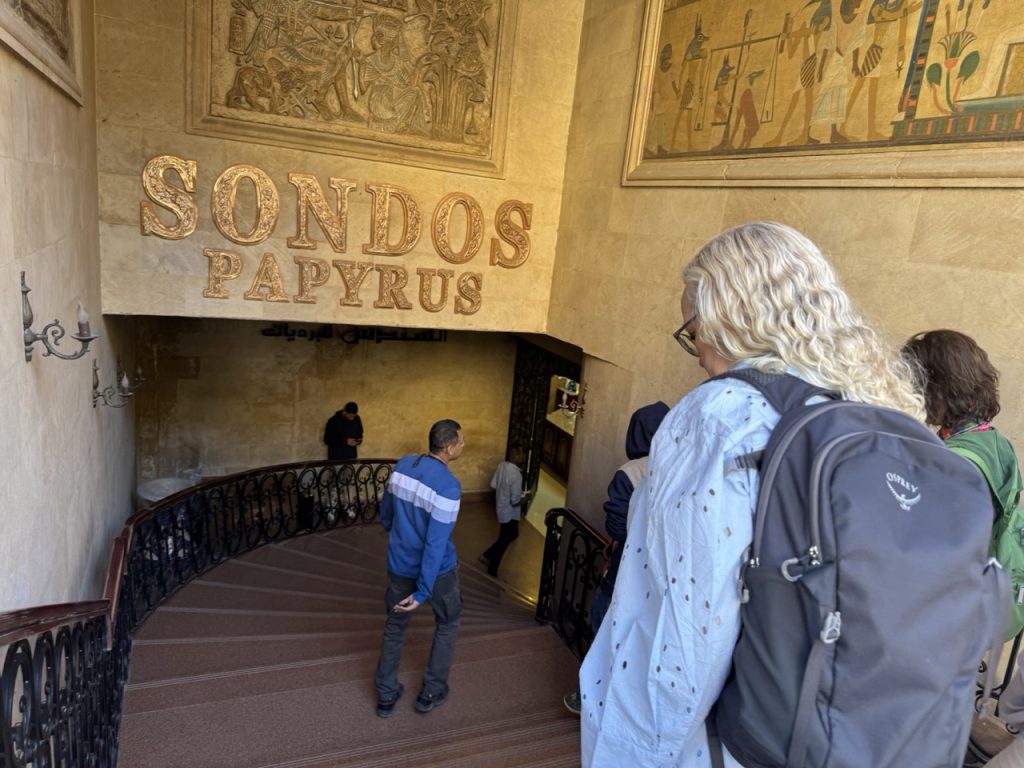
Mohamed was on hand to advise how to barter for the best price, and this is a real advantage of this package tour.
Day 8: Abu Simbel
It was up early to catch the plane to Abu Simbel which took less than 1 hour flying time. The temple was absolutely teeming with tourists on arrival, mainly due to the short window allowed to visit here.
The number of visitors inside the building did make it possibly one of the least enjoyable place to visit due to everyone jostling for position to get their photos. Over-crowding aside (not Uniworld’s fault, incidentally), the temple itself was certainly a very interesting destination.
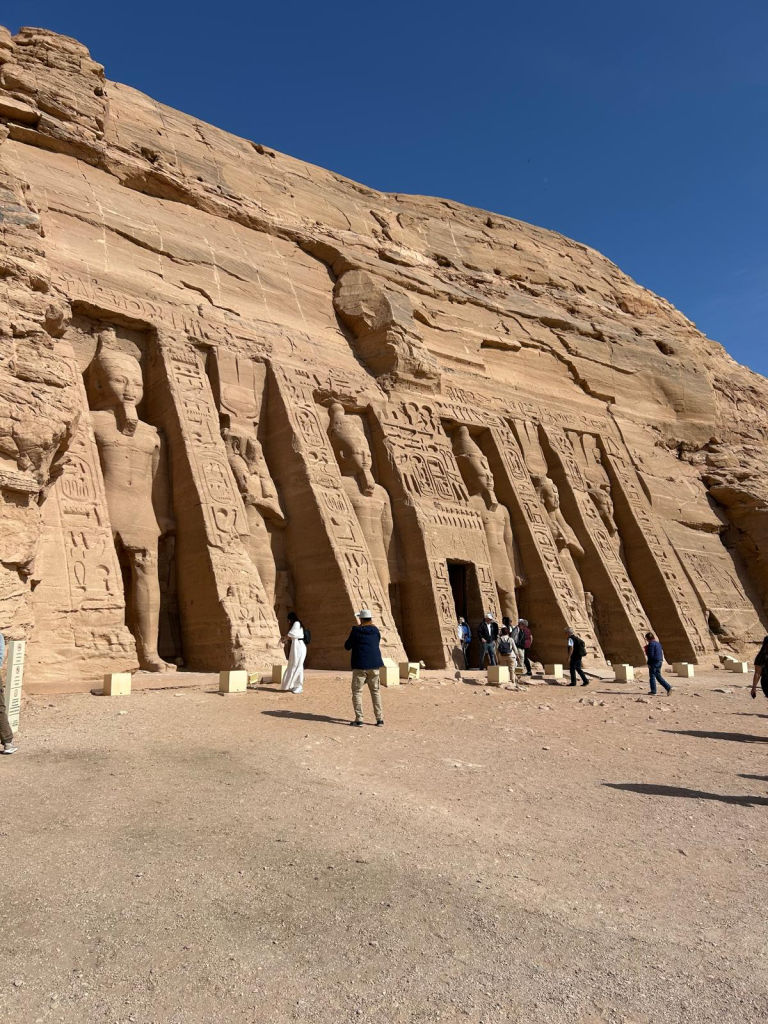
The Story Behind Abu Simbel
During his reign, Rameses II faced ongoing conflicts with the Sudanese people, who frequently crossed into Egypt. At the time, Aswan marked Egypt’s southern boundary. In order to strengthen his control, the Pharaoh expanded Egyptian territory beyond this border.
His strategy was to make the newly conquered land still appear as Egypt so that when the Sudanese crossed over, they believed they were still entering Egyptian territory – when, in reality, they had already been defeated.
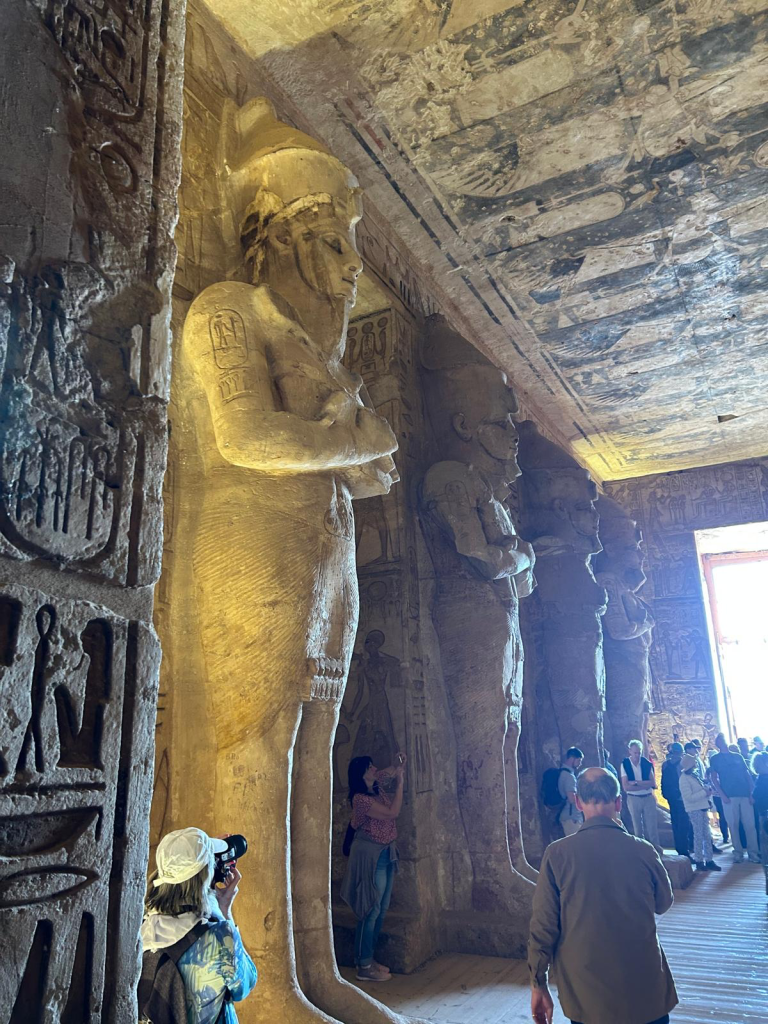
To secure his dominance and prevent further invasions, he built Abu Simbel, a magnificent temple complex, as a symbol of power and peace. The main temple was dedicated to himself and the gods, while a second, smaller temple was built for his wife, Queen Nefertari.
The Main Temple: A Monument of Power
The grand temple, carved directly into the rock, follows the same architectural style as many other Egyptian temples but stands out for its scale and detail. One of the temple’s most striking reliefs depicts the Pharaoh returning from battle with a lion walking beside his horse—an ancient symbol of victory.
Inside the sanctuary, the alignment of the temple was carefully designed so that sunlight would illuminate three of the four statues at the back, leaving only the god of darkness in the shadows. This was a powerful statement, reinforcing the Pharaoh’s divine connection. The ceiling is adorned with images of vultures, symbolising protection, while the entrance chamber features massive pillars, giving an overwhelming sense of grandeur.
The Temple of Nefertari: A Tribute to Love
The second temple, dedicated to Queen Nefertari, is filled with symbols of love and devotion. It features representations of the goddess Hathor, depicted as a cow with a lotus flower for a tail, sailing on a sacred “love boat” with lotus flowers adorning both ends. The boat floats through water, surrounded by blooming lotus flowers, reinforcing the theme of love and renewal.
Throughout the temple, scenes show offerings of lotus flowers, as well as the symbolic pouring of water, accompanied by the ankh (the key of life), a recurring motif in Egyptian art.

One fascinating detail is the recognition of the temple’s architect, Anni, who was allowed to inscribe his name on the temple – a rare honour in ancient Egypt. This suggests that he was highly respected for his work and that the temple was considered a masterpiece of its time.
Day 9: Esna Temple
Temple of Khnum at Esna was another fascinating excursion that should not be missed. What was particularly striking about this well-preserved temple were the vivid colours can still be seen in many areas.
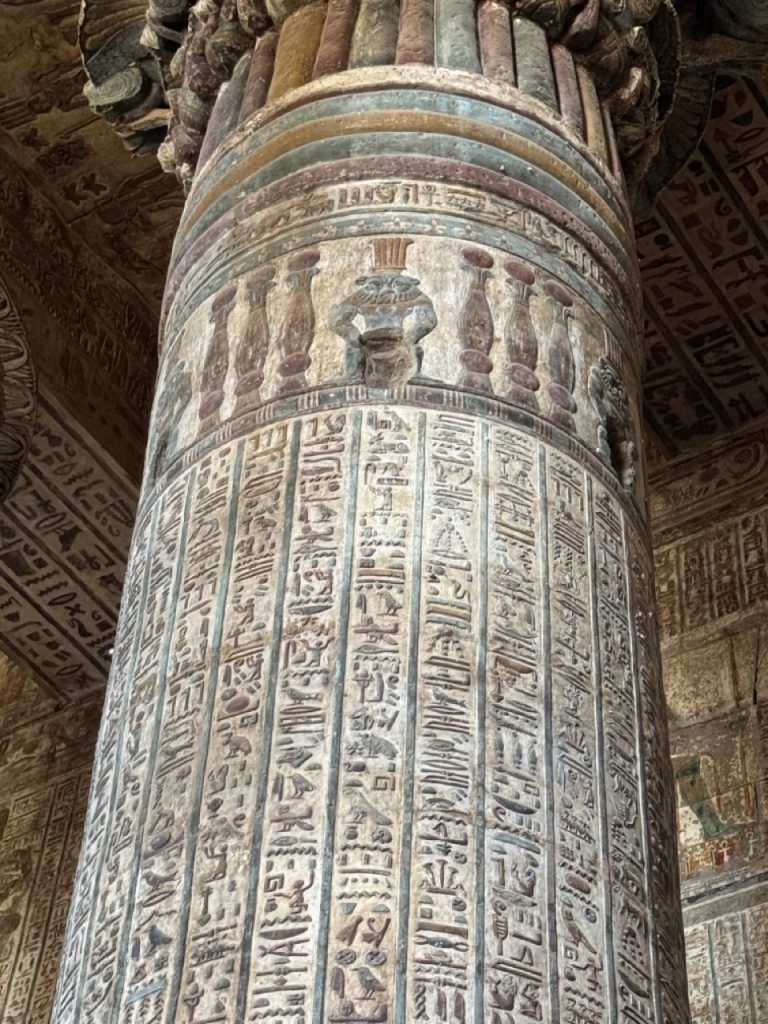
Day 10: Return to Cairo & Grand Egyptian Museum
The group were in for a real treat on this day. The new Grand Egyptian Museum awaited after flying again from Luxor to Cairo airport. So, after another early start, it was straight off the bus and to the museum while the suitcases were taken by Uniworld to keep on the bus. There really is not a moment wasted on this tour!
Just take a look at these photos I took and you will get an idea of just how amazing this museum is.
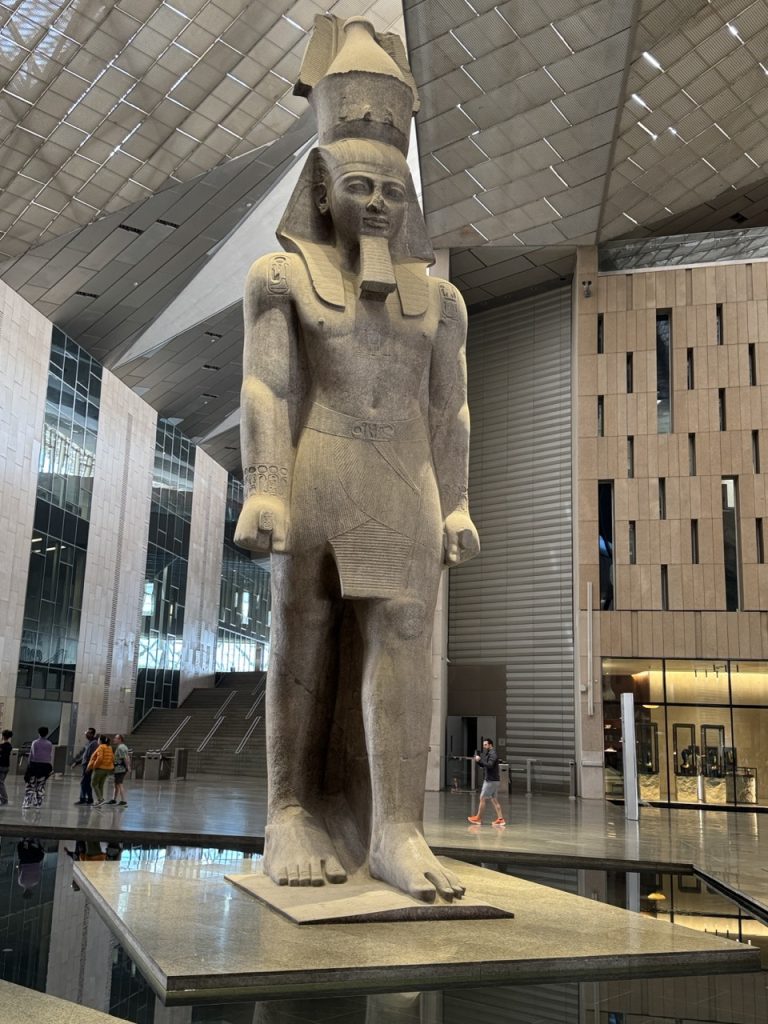
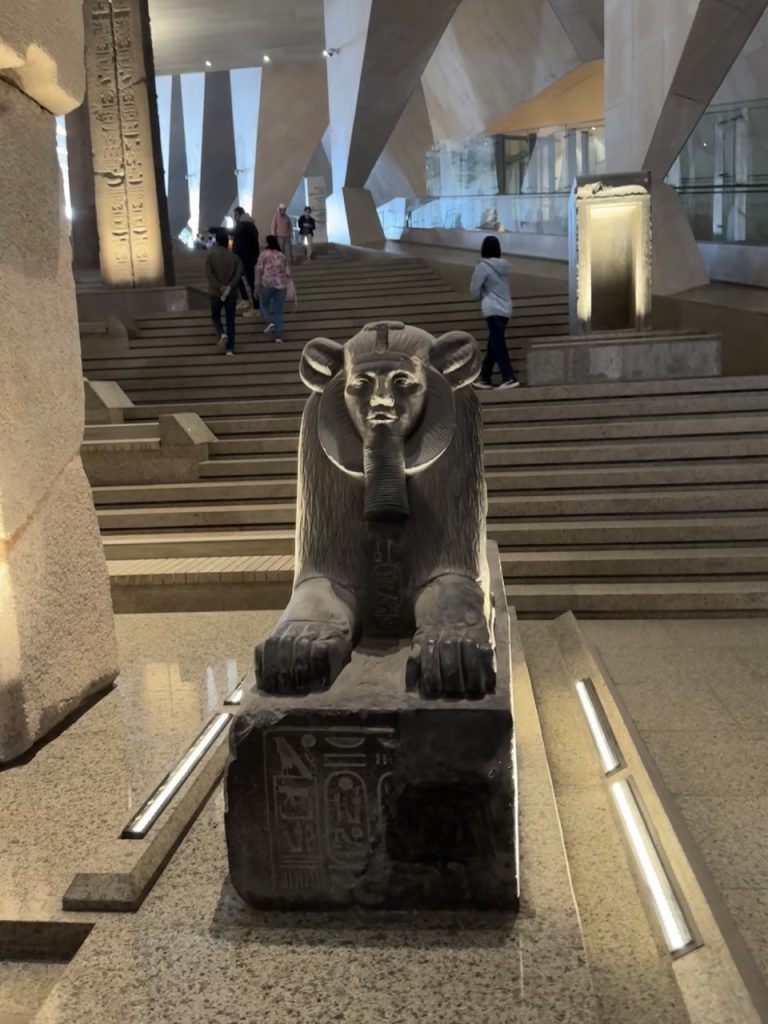

Day 11: The Pyramids, Sphinx & Carpet
What’s possibly the biggest attraction to Egypt is left until last on this tour. Yes, the amazing pyramids and the great Sphinx. Thanks to the smart juggling by Mohamed, he swapped some of the order around on this day after keeping an eye on the weather. And it worked out perfectly.
These structures really do have to be seen by one’s own eyes to be fully appreciated. My photographs don’t really do it justice, but here is an insight of what can be seen there.
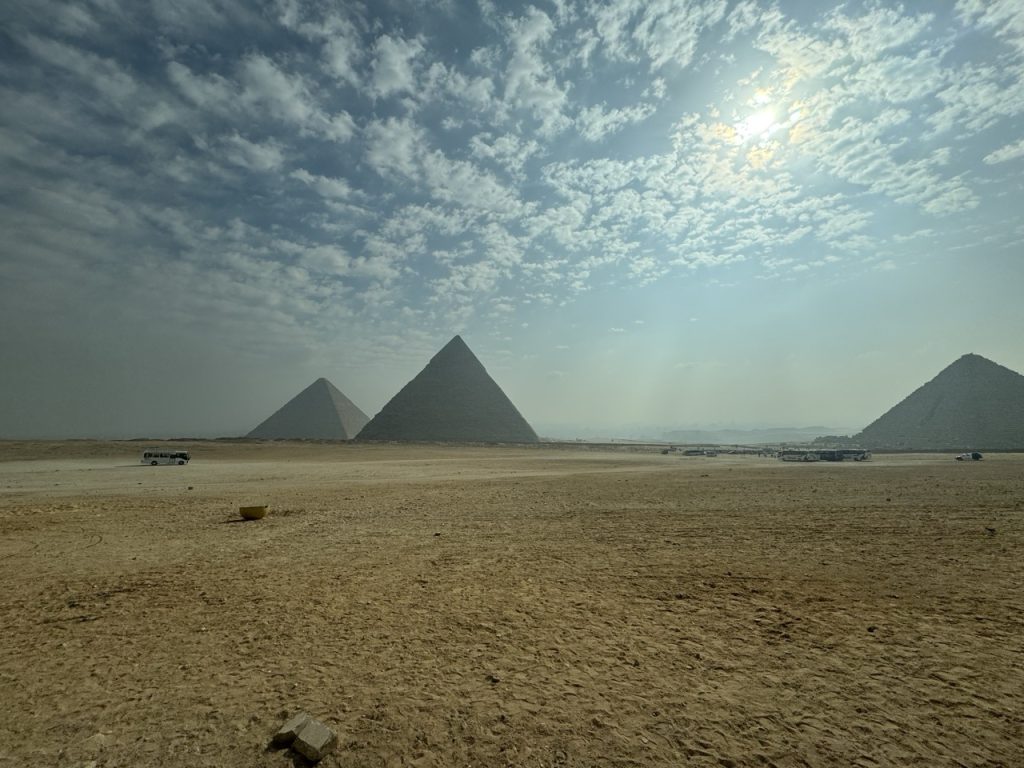
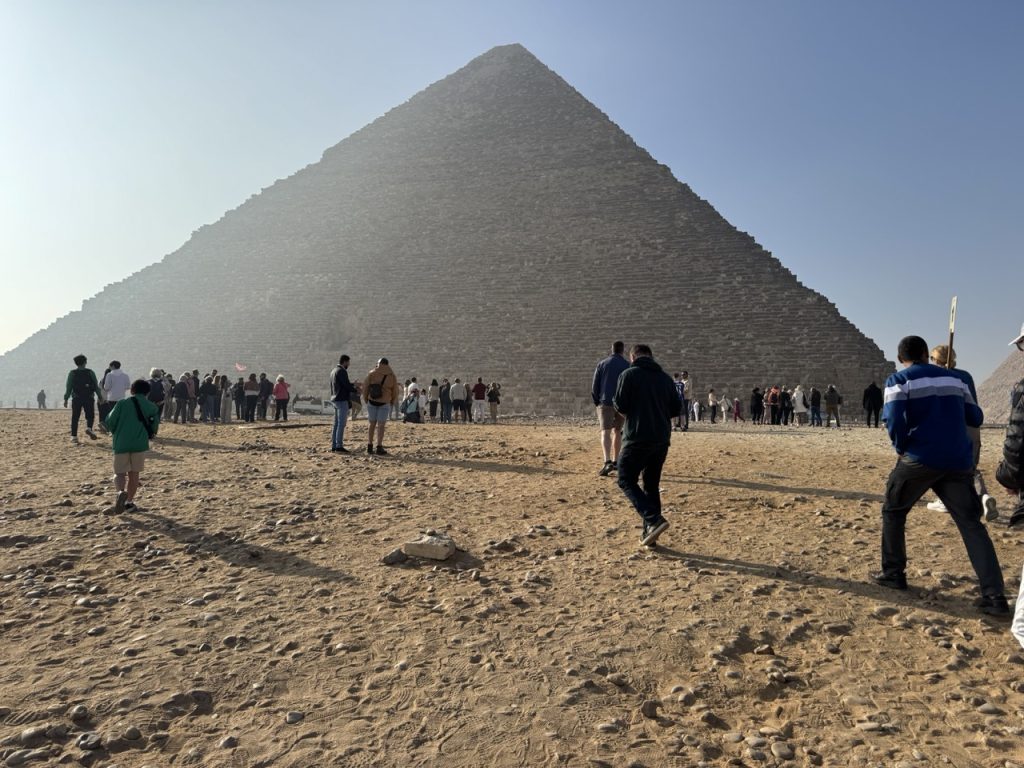
After that mind-blowing trip, we stopped off at an establishment that made and sold carpets. We marvelled at the workmanship on display as each thread was individually added to the carpets being made by hand. Silkworms making silk for some of the carpets could even be seen.
Upstairs there was also an opportunity to see the products and to make a purchase if desired. Mohamed was on hand to advise on the “right” price.
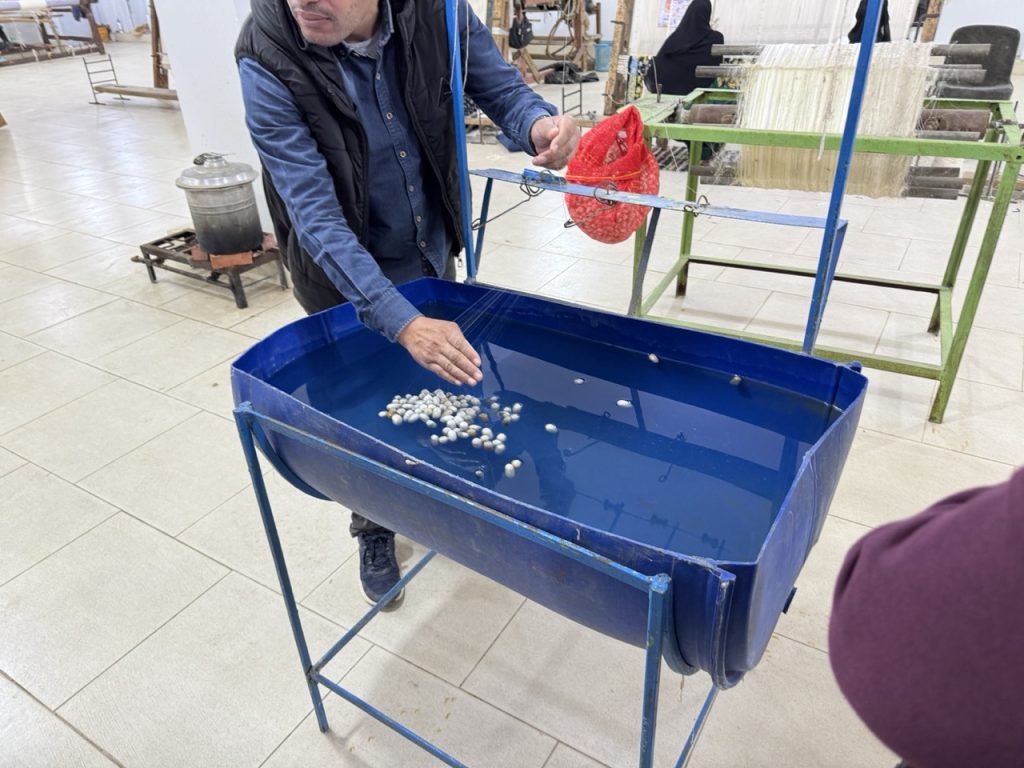
Day 12: Farewell & Return
Depending on one’s flight time, either another early start or a leisurely morning packing will await on the final day.
A final buffet breakfast in the Four Seasons Hotel was another nice experience before heading off.
Uniworld also offers a post-cruise/tour 5-day extension to The Red Sea which we did not participate in during this review. It covers excursions from Sharm El Sheikh.
Traveller Tips
It’s a great idea to plan a trip like this in February/March before things get too hot in Egypt. This felt like very comfortable weather indeed. In fact, pretty perfect. It even rained (rare) a couple of times, but the showers were short, sharp and refreshing.
There is always the distinct possibility that travellers might experience some ‘tummy trouble’ when visiting the region. Both of us did fall foul of this and it’s not something that can be described as pleasant. However, it’s something that you just have to accept if it happens and you may miss some excursions as a result. Generally speaking, it can be over within a day or so. Travel prepared for this by bringing the appropriate medical remedies.
There are also, of course, mosquitoes in the region. Pack some DEET and they will avoid you if you spray it on. Sun screen is also recommended as you will be spending a lot of time in the Egyptian rays.
Recommended or Not?
Egypt’s history is the star of this incredible adventure which is sure to be on many people’s bucket list. And this Uniworld tour does not disappoint. There is just so much crammed in that you could lose track of what you have experienced very quickly.
The attentive staff on board the SS Sphinx are super polite and helpful, and we could not fault a thing about anything at all. They worked seamlessly and you got the feeling that they were like one big family.
Mohamed is one of 18 Uniworld Egyptologist tour guides that you might be lucky enough to have with you. It must be said that if one attempted a trip to Egypt without the expertise of the guides, it would be a lot more difficult.
We have heard stories of unscrupulous people preying on tourists in several different ways but the package tour shields you from all of these potential pitfalls. The benefit of the local knowledge from all of the Uniworld staff is a massive plus point that should not be underestimated.
The Splendours of Egypt and the Nile comes very highly recommended indeed. It really is the trip of a lifetime.
